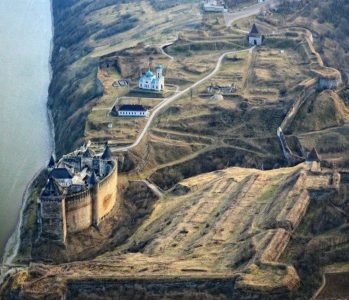ABOUT: (Opened: 1325) The Khotyn Fortress (Ukrainian: Хотинська фортеця, Polish: twierdza w Chocimiu, Turkish: Hotin Kalesi, Romanian: Cetatea Hotinului) is a fortification complex located on the right bank of the Dniester River in Khotyn, Chernivtsi Oblast (province) of western Ukraine. It is situated on a territory of the historical northern Bessarabia region which was split in 1940 between Ukraine and Moldova. The fortress is also located in a close proximity to another famous defensive structure, the Old Kam’yanets Castle of Kamianets-Podilskyi. Construction on the current Khotyn fortress was started in 1325, while major improvements were made in the 1380s and in the 1460s
Lively Conversations:
There were actually three other big fortresses in close proximity: Kamieniec Podolski, Żwaniec and Holy Trinity Trenches.
If you go a little bit south in romania you will find even more fortress + the system of fortified churches who served as a chain of military outposts.
The whole Dniester was highly fortified. But those fortresses are in 30km range.
Holy Trinity Trenches looks like it’s on prime real estate. It would be difficult to be an invading army against that.
They were made during Polish-Turkish war in 1692, Turks still held Kamieniec Podolski, and Poland wasn’t able to take it back, so they decided to block the supplies coming from Moldavia.
Fun fact: today’s a phrase in Polish. If you want to describe someone who have ultra religious, conservative views you can say that he “sits in Holy Trinity Trenches”
The Khotyn Fortress is built in a depression (Valley) so that from the land side you don’t see it until you’re almost on top of it, but there are still good views over the river. Pretty cool and a contrast to the classic fortress on a hill!Do you know why it was built that way by any chance? It seems like it would lower the defensibility of the walls, you could just place some siege weapons on that hill and rain heck into the fortress.
They fortified the hill, too.
The attached supporting picture was taken by photographer Yuriy Litvinenko from Odessa, Ukraine.
Yuri Litvinenko was born in 1961. He lives in Odessa. Candidate of Physical and Mathematical Sciences. Photographer of the Odessa National Academic Opera and Ballet Theater and the Odessa Aircraft Squadron. Since 1999 a member of the Odessa Photon-2 Photographers Club, since 2002 – the National Union of Photo Artists of Ukraine (NSFHU). Conducted 3 personal exhibitions. In 1995, the photobook “Cabbage Stories” was published, in 2009 – “There is a City”, in 2010 – “Odessa Region”. Winner and winner of national and international photo exhibitions. Extreme photographer. Specialization: wild animals, horses, underwater photography and aerial photography. About a hundred flights on different aircraft. More than 300 hours in the air. Extreme photography and art photography workshops.
Source: https://khmelnytsky.com.ua/ua/fullnews/215411 (Google Translate)
The Celestial Ukraine exhibition consists of 50 photographs taken from a height. The photo exhibition will open in Khmelnitsky on July 14 at 4:00 pm and will run until August 16. You can view the works of art at: Proskurovskaya Street, 56.
Transnistria belonged to Ukraine anyway, just like Bessarabia, Herza and North Bukovina belonged to Romania. Romania and Ukraine should trade them back. Furthermore, Romania could offer in this trade:
support in getting Crimea back to Ukraine
support in joining NATO
support in joining the EU
This could prove very helpful for Ukraine, especially considering a single EU member can veto new members joining the union.
The real threat for both Romania and Ukraine is Russia. So it would be best if they worked together.
Fun fact: Impressive, two grand and very important battles in the 17th century against muslim invasion and islamisation of Europe – Battle of Khotyn – 1621 A.D. and 1673 A.D.: j
In 1621 the Turkish army (over 100 000 man) was much more numerous (two or three times) than the Polish army. Polish forces won the battle resisting Turkish flood, mostly thanks to the winged hussars charge. Polish force in total were about 45 K of soldiers.
In 1673 A.D. the number advantage of turks was much larger than the first time (over 100,000 soldiers against less than 30,000 Polish soldiers), but this time also Polish forces won:
Polish force in total: 29,052 soldiers:- Winged Hussars: 1670 (12 banners)- Armored vehicles: 11,105 (Armored vehicles: armored knights on horses)
(110 banners)- Dragonia: 5,828 (19 banners)- Wallachian cavalry: 1,619 (19 banners)- Archery: 342 (3 banners)- Infantry: 7,988 (23 banners)- Ungarian infantry: 500 (4 banners)
There was also Polish-Moldavian battle of 1509, and Russo-Turkish battle of 1739. Also two smaller battles in 1530 and 1616.
Also in 1621 some historians estimate that Polish army was 75k strong (Cossacks constituted half of this army), they also estimate Ottoman army was 100-150k. Huge clash.
During Khotin battle in 1921 polish side had around 70-80k soldiers due to an agreement with cossacks. Earlier in 1921 polish government understood the treat of turks and started to look for an ally. First they tried Habsburg Austria and Holy Pope but got rejected, so then they had to deal with a rebellious group within their borders – cossacks. Sagaidachii, who at the time was a hetmen, agreed and supplied 45k army to help them. In 1673 Turkish force had been around 35k men against 30k of Poland which is reasonable.
Earlier in 1921 polish government understood the treat of turks and started to look for an ally. First they tried Habsburg Austria and Holy Pope but got rejected, so then they had to deal with a rebellious group within their borders – cossacks. Sagaidachii, who at the time was a hetmen, agreed and supplied 45k army to help them.
It was a bit different. Turkey attacked Poland because of Cossacks, who earlier deposed Sahajdaczny, elected Borodawko and started attacking Turkish fortresses and coast. When Ottoman army was approaching they restored Sahajdaczny and joined Polish army. Also 45k is unlikely, Cossacks gathered probably 20-25k strong army. 45k was way beyond their capabilities at that time.
https://wpolityce.pl/historia/307573-chocim-1621-wielkie-zwyciestwo-rzeczypospolitej-i-ogromne-straty-tureckie In 1621 there were some cossacs. However, the greatest strength was in the Polish army, well trained and armed. In total it was (not precise data) 45-65K on Polish side vs 105K of Turkish side.
The data is not precise, and all we know is that “Cossacks army was composed of 25,000–40,000 troops—mostly infantry. (…) There were 25-26 thousand Polish troops – [a lot of hussars, armored horsemans etc.. ](…) Ottoman Turkish army numbered 70-75 thousand people, it was supported by around 20,000 Tatars and 12 thousand Moldovans and Wallachians”.
No totally different place. Katyń is in Russia, near Smoleńsk. Chocim is in Ukraine, near Romanian border.



